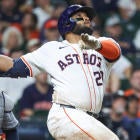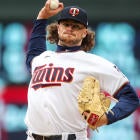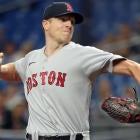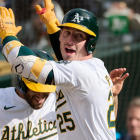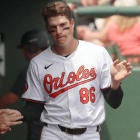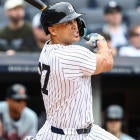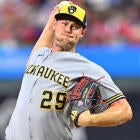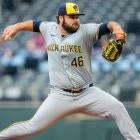How weird was that?
As weird as could be expected, probably. Reduce a sport intended to be played over 162 games down to a seven-day sample, and it’ll always play out like a living dream sequence where everything seems familiar but also plainly and uncomfortably wrong.
If you’ve followed baseball for any length of time, though, you can usually differentiate between early-season noise (Miguel Cabrera is 3 for 24 -- oh noes!) and the more legitimate developments that catch you completely and utterly off guard.
Here are the 15 surprises that have me questioning if everything I know is wrong:
1. Nobody can hit Kendall Graveman
What’s amazing is that hittability was the most defining characteristic for the sinkerballer through his first two-plus seasons when he averaged just 5.6 strikeouts per nine innings.
But now his sinker, which used to touch 94 mph on a good day, is peaking at 97-98, and with the way it darts and dives at the plate, he’s not only getting away with throwing it 85 percent of the time, but is all the better for it, striking out nearly a batter per inning just as he did this spring.
I mean, if there was ever a pitcher who passes the eye test ...
Maybe this harder sinker is just a gimmick that the league eventually figures out, or maybe Graveman is the next Brandon Webb, who won a Cy Young throwing his sinker 75 percent of the time. Either way, I’d rather it play out with him on my roster.
2. Delino DeShields isn’t playing at all
DeShields led all players in stolen bases this spring, going for 14 for 14, and tied for second in walks, inspiring many a feature piece about his re-commitment to becoming a table-setter, all of which seemed to culminate in him winning the starting left field and leadoff job.
Psych!
Not only was he not in the opening day lineup, but he started just two of the Rangers’ six games the first week, getting removed early from one.
It was a decision that defied all expectations, both based on spring performance and everything the Rangers were sharing with the media. It’d be one thing if they wanted the chance showcase utility player (and former top prospect) Jurickson Profar for a possible trade down line, but why is Ryan Rua an equal part of this mix?
At this rate, I’m rooting against the whiff-tastic Joey Gallo just so he doesn’t muddle things further when Adrian Beltre forces him off third base in a few days.
3. A closer has already lost his job
Maybe it’s pretty normal for a closer to lose his job in the first week, but that’s never the expectation when you invest in an intended ninth-inning man, even knowing he’s on thin ice.
Manager Pete Mackanin’s faith in Jeanmar Gomez seemed especially misplaced given that he’s the one who removed Gomez from the role when the 29-year-old was putting together an 8.33 ERA in the second half last year, but he said Gomez deserved the chance, so naturally, we expected him to get a chance.
Instead, Mackanin hit the panic button after Gomez’s second appearance, and so now we move forward with Joaquin Benoit. A surprise in itself? Not really. Hector Neris is pre-arbitration, after all, and Benoit has a 2.40 ERA, 0.98 WHIP and 10.0 strikeouts per nine innings over the past seven years.
4. Ryan Zimmerman still has something left
Guess who’s hitting more fly balls this year?
Everyone but Ryan Zimmerman.
But he so badly wants to join in the latest hitting craze, and with some of the adjustments he has made, it may bear out over time. One adjustment that’s already working in his favor: attacking his pitch instead of overworking the count and putting himself in a defensive position.

The left image shows how often he swung at pitches in each part of the zone last year. The right image shows this year, which uses a much smaller data source and is more polarized as a result. But the bright splotches of red still reveal an aggressive approach, and the opposing diagonals of red show that he’s swinging at his pitches and not the pitcher’s.
There’s also some talk of him improving his posture at the plate -- “staying stacked,” or something or other -- but more than anything, the fact that he’s healthy right now after contending with hamstring, shoulder, thumb, foot, oblique and wrist injuries the past three years gives him a chance of returning to a high level at age 32.
I mean, who has better RBI potential than the hitter following Trea Turner, Adam Eaton, Bryce Harper and Daniel Murphy?
5. Everybody is going on the DL
We’ve already seen it play out for Roberto Osuna, Rich Hill, Trea Turner, Buster Posey and perhaps even Jackie Bradley. Players who are reported to have suffered minor injuries are suddenly winding up on the DL. Is downplaying an injury the default response until a team knows more?
Nope. Teams are simply taking advantage of a new rule.
The 15-day DL is no more. It’s now a 10-day DL. And while a five-day difference may not seem like a big deal, understand the hardship that comes with playing a man down for even three or four days. If a DL stint can prevent that while also ensuring that nobody is rushed back from a day-to-day injury, prolonging the recovery, it’s a win-win.
It’s perceived as a nuisance among Fantasy owners right now because nobody likes to see their players go on the DL, but understand that a DL stint also doesn’t mean as long a wait as it used to. In the long run, I think we’ll see it as more of a blessing than a curse. Day-to-day was always frustratingly vague. A DL stint brings some finality to the situation, especially when you learn to see it coming.
6. Greg Holland is every bit the closer we remember him being
When Holland was in the conversation for best closer in baseball, he’d get hitters looking for his 98-mph fastball to swing over the top of his downward-breaking slider. So does the same formula still work with his reconstructed right elbow? You tell me.
Holland needed two years to recover from Tommy John surgery and faced some concerning reports about his velocity along the way. It’s worth noting, then, that his fastball is peaking more at 96 than 98. But he’s throwing his slider, one of the more taxing pitches on the elbow, as much as ever and has gotten his highest whiff rate with it since 2011, before he even become a closer.
The six strikeouts in four hitless innings make sense, then, and as much as the Rockies’ unique situation allows for it, he should once again compete with the elite at the position.
7. Carlos Santana is on the verge of outfield eligibility
Nothing slips by Indians fans, I’m sure, but the rest of us may have overlooked that Santana has been the top choice to fill in for the injured Lonnie Chisenhall in right field. He has gotten more starts there (three) than either first base or DH, putting him just two appearances away from gaining eligibility at the position.
First base isn’t quite as overloaded as in past years, so maybe the added eligibility won’t make a difference for you, but outfield is unusually weak at the top. And Santana would quite possibly be a top-15 option at the position, particularly in points leagues where his walks more than make up for his suspect batting average.
Even in Rotisserie leagues, which traditionally require five outfielders, the unexpected versatility will greatly improve your options going forward.
8. The spring’s most effective pitcher had the least effective debut
Which pitcher is that? Why Francisco Liriano, of course.
His season debut Friday at Tampa Bay in which he allowed five earned runs in just one-third of an inning, walking four, was a far cry from that.
I could have just as easily said Masahiro Tanaka, though.
He has an 11.74 ERA through two starts, having walked four in his last one.
It’s a reminder that what we see in spring training is rarely true to the regular season, sure, but in these particular cases, I don’t think the regular season numbers are any more indicative.
Tanaka’s situation may simply be early-season noise. His track record speaks for itself, and the walks especially would seem to conflict with everything we know about him.
Liriano, though, has his share of skeptics coming off his worst season in four years, but he rebounded with a 2.92 ERA, 1.18 WHIP and 9.5 strikeouts in his 10 appearances after coming over from the Pirates. His issue Friday is one that has popped up from time to time in his career. He gets amped up, overthrows, messes up his mechanics and then ... walk city.
Pitching coach Pete Walker helped him find his release point after the trade, though. The Blue Jays seem to have a pretty good read on him. Especially after the way his spring training went, I’m confident in Liriano bouncing back.
9. Matt Holliday has started every game
He’s 37 years old and averaged 91.5 games the previous two years. So how could I have expected Holliday to be the rock in the heart of the Yankees batting order? Shoot, how could the Yankees?
Granted, he never had the DH spot available to him in all those years with the Cardinals, and since playing the field is the more taxing part of the game, that role has a history of prolonging careers. Still, I thought the Yankees would use it to spell other players from time to time. Didn’t Aaron Judge almost miss out on the right field job because of Aaron Hicks? What’s he doing now? And Chris Carter’s only role is to back up Greg Bird?
Not that I’m complaining. I’d rather see Holliday play than those two. For all of his injuries over the past couple years, he has held pretty steady as an .800 OPS guy and should remain a viable mixed-league contributor if the DH role keeps him on the field, especially as the cleanup hitter.
10. Chris Devenski has served as sort of a piggyback starter
Devenski is the No. 4 reliever in Head-to-Head points leagues so far, and yet he has made only two appearances.
How is that possible? They each lasted four innings, and they each featured seven strikeouts.
One also resulted in a win, which is typically the most valuable Fantasy contribution, but that’s neither here nor there. It stands to reason that if he’s pitching four innings at a time, he’ll often be the picture of record. So is this a legitimate role for him?
It’d be a new one, at least during the time any of us has been playing Fantasy Baseball. If that first week is a sign of things to come, Devenski is less a reliever than a piggyback starter, preserving the rest of the bullpen by giving the Astros a bundle of innings when they need it most
It’s not the craziest idea at a time when innings are at a premium, but I can’t help but wonder why Devenski wouldn’t eventually start himself if his relief appearances keep playing out this way. For Fantasy purposes, I don’t know that he’s especially valuable in this role -- not in standard 12-team leagues, anyway -- but as a prospective starter, sure.
Of course, since both of those four-inning appearance came in extra-inning contests, it’s still possible Devenski will serve a more traditional relief role more often than not.
11. Steven Souza has struck out only three times
The reason Souza’s power potential and whatever else he brought to the table offensively have always been negligible in Fantasy is because he has struck out in about 34 percent of his plate appearances, one of the worst rates in all the majors. Making contact is the most important step, and he’s Exhibit A as to why.
So him striking out just three times in his first 33 plate appearances is a miracle unto itself.
And success has followed, including his first home run Sunday. He’s the No. 11 outfielder in Head-to-Head points leagues so far, and we can all applaud him for that.
But considering he struck out in nearly one-third of his plate appearances this spring, I’m not ready to believe he has turned over a new leaf.
12. Evan Gattis has had to fight for playing time
The surprise is less from me than the rest of the Fantasy-playing world. My thinking is that if the Astros signed a DH and traded for a catcher this offseason, what role would you expect Gattis to have?
But I feel like I may be partly responsible for the confusion simply by virtue of ranking Gattis as a top-five catcher.
Understand, though, that ranking a player in the top five at catcher isn’t like ranking him in the top five at any other position. Catcher is a disorganized mess of semi-productive bats, only three of whom (Buster Posey, Jonathan Lucroy and Gary Sanchez) will give you a distinct advantage over your competitors.
The rest nobody cares to untangle because they’re all so similar and because -- outside of two-catcher leagues, anyway, which are becoming fewer and fewer -- they’re hardly in short supply.
Most catchers sit a lot anyway, so if Gattis plays just 105-110 games, he’s not at a great disadvantage. In fact, it would be much like his first two years in Atlanta when he still exceeded 20 home runs. And then, the likelihood of a Beltran and/or McCann injury could set him apart from there.
13. Mike Scioscia thinks Cam Bedrosian is his Andrew Miller
With Huston Street sidelined by a strained lat to open the season, Bedrosian seemed like the obvious choice to open the year as Angels closer. He’s their best reliever to begin with, and no one else is really capable of the job.
But Scioscia refrained from naming the closer to begin the year, and even after turning to Bedrosian for the Angels’ first save opportunity April 4 (which the 25-year-old converted flawlessly), the manager didn’t care to assign roles.
“We’ll use him in those high leverage situations later in the game, whether it’s a save situation or not,” he told The Orange County Register.
So it’s less a matter of Scioscia just being stubborn (and perhaps giving himself an out if he opts for Street in the role later) and more a case of an old-school manager being surprisingly forward-thinking.
The entire baseball world saw the impact Miller made in such a role during the postseason, so you can understand why even traditionalists might be willing to give it a shot, especially when there’s such a clear standout as Bedrosian.
But the difference for Scioscia is that he doesn’t have a Cody Allen to close the door in the ninth. It doesn’t matter if Bedrosian is preserving the lead in the seventh if someone else is coughing it up thereafter. I don’t think the Angels bullpen is best equipped for this change, and I think Scioscia will figure it out sooner than later.
14. Brett Gardner leads the majors in stolen bases
Adding two more to the tally Monday, Gardner is up to five, edging NL leaders Chris Owings (himself a surprise), Billy Hamilton and Eduardo Nunez by one.
Gardner did lead the NL in steals one year -- collecting 49 in 2011 -- but he hasn’t even reached 25 in a season since. He’s a perfect 5 for 5, though, and I’ve always argued that the stolen base is primarily a decision-based stat. A lack of ability will often make the decision for a team, but if a team is willing to send a runner as fast as Gardner, he figures to make good on it.
Prior to the season, manager Joe Girardi challenged both Gardner and Jacoby Ellsbury to score 100 runs this year, which is a number a player can’t control for himself, but Gardner has taken it as a mandate to run more.
“I’m definitely trying to be more aggressive,” Gardner told The Record. “Those guys would rather have me on second and third.”
If Gardner gets back to stealing 30-plus bases in an era when stolen bases are scarce, he’ll be a bargain pick in Rotisserie leagues.
What about Owings? I wouldn’t get too attached with Ketel Marte hanging out at Triple-A.
15. Ervin Santana threw back-to-back two-hitters
One would be easy enough to tune out as early-season noise, but two in a row? That’s enough to catch my attention, and judging by his 82 percent ownership rate, I’m not alone.
And the truth is I wouldn’t expect Santana to be a fundamentally different pitcher than he was a year ago. But that pitcher was supremely underrated, especially when you consider he had a 2.41 ERA over his final 18 starts.
At age 34, he won’t suddenly become a strikeout-per-inning type, and I can’t guarantee he’ll win a bunch of games with his lackluster supporting cast. But he will consistently pitch deep into games, providing a respectable ERA and WHIP, and at a time when so many of the upside pitchers in Fantasy Baseball are still finding their footing in the majors, battling inconsistency and facing increasingly restrictive innings limits, a little reliability goes a long way.
You probably picked up Santana just as an extra two-start option in Week 1, but he may never give you reason to drop him.





























